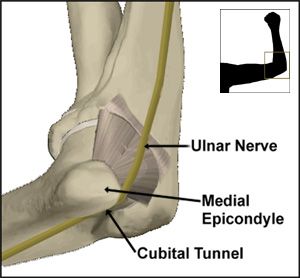- tingling on the ulnar side of the right hand and the little finger
- minimal wrist pain (3/10) upon prolonged wrist flexion or extension
- (+) Phalen's Test
- (+) ulnar nerve compression test on right elbow
- (-) nerve-percussion test on right wrist
Rule out: carpal tunnel syndrome
Test to take: EMG-NCV

Cubital tunnel syndrome is a condition that involves the ulnar nerve as it crosses the elbow. The ulnar nerve provides sensation to the ring and little fingers as well as making some of the muscles in the hand work. When it is damaged, numbness and tingling occurs in the fingers. It can feel as if it involves the whole hand, although it is only two fingers. The hand may also feel weak or clumsy. Sometimes the inside of the elbow will be painful.
The ulnar nerve sits in a groove (cubital tunnel) towards the back and inside of the elbow. Normally it is protected. However, it can be bumped which results in the "hitting the funny bone" sensation. Long term damage to the nerve can come from repeated bending of the elbow (such as operating levers or lifting), leaning on it (such as reading or driving) or a direct blow.
The diagnosis of cubital tunnel syndrome begins by asking specific questions as to which fingers feel different, if the hand is weak and where any pain is located. The physical examination involves tapping on nerves to determine where they are irritated. It is important to determine that other causes of "pinched nerves" are not present such as diabetes or kidney disease. The ulnar nerve can also be trapped in other areas such as the neck. Sometimes electrical diagnostic tests such as EMGs or nerve conduction studies are needed. These tests measure the speed of the nerve and how quickly information travels down the nerve. An area where the nerve is pinched will slow the speed.
Treatment usually starts with resting of the elbow. Keeping the elbow straight, especially at night reduces the amount of "stretch" on the nerve. An elbow pad rotated into the bend of the elbow can stop the elbow from fully bending. Activities that put stress on the cubital tunnel should not be done. Sometimes anti-inflammatory medicines are helpful.
Surgery may be needed if symptoms do not go away. This consists of "decompression", which removes the roof or one wall of the tunnel to decrease the pressure on the nerve, or "transposition" which moves the ulna nerve out of the cubital tunnel to another place. After surgery, most patients must wear a splint and rest the arm. Therapy after surgery may be used to help you get motion and strength back.
While treatment can help symptoms of cubital tunnel syndrome, not all patients recover completely after surgery. If your symptoms are not severe or present for a shorter time, you have a better chance of a complete recovery. Sometimes the changes you make at work and in leisure activity will have to be permanent for you to stay free of symptoms.
***Taken from this site.
2 comments:
eeek! ano ba naman yan? pataas ng pataas yung syndrome na yan ah. next nyan yung crutch palsy na.
buti na lang wala akong crutches noh? heehee! :)
Post a Comment